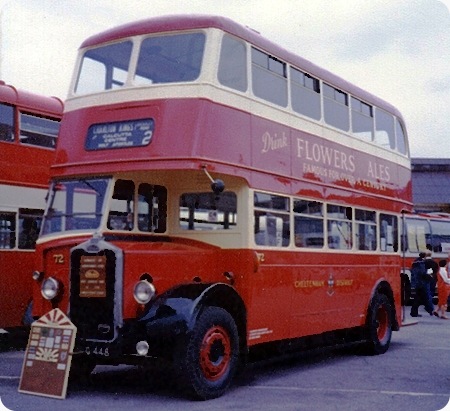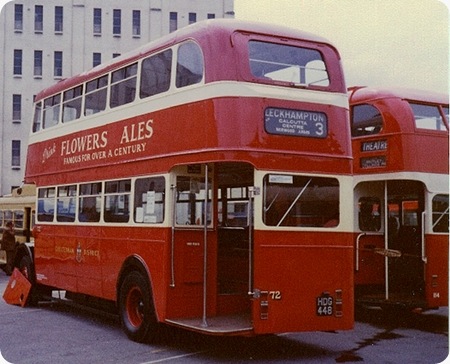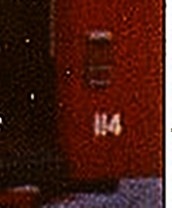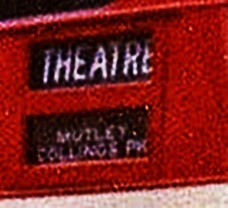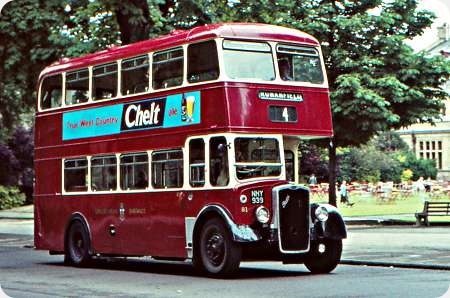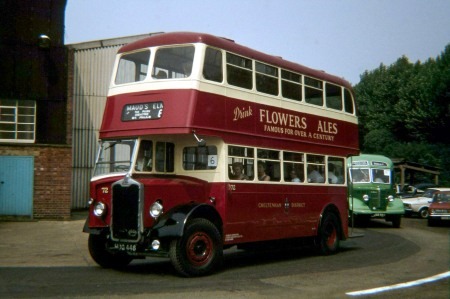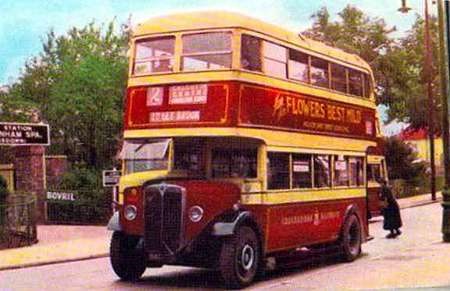Cheltenham District – Albion Venturer CX19 – HDG 448 – 72
Cheltenham District
1949
Albion Venturer CX19
Metro Cammell H56R
Cheltenham District was never quite the public transport company it seemed. Always privately owned until the late ‘40’s, it always appeared to be a municipal operation, compounded by the town crest its vehicles always bore on the sides.
In tramway days, a sprinkling of Guy BB’s supplemented its tram services, but, with tram abandonment, it ordered 11 Guy Invincible double-deckers with open staircases and open tops. This degree of discomfort as late as the end of 1929! Worse was to come, for many of them were rebodied in 1937, still with open tops, but the dubious improvement of enclosed staircases! The war prolonged their existence, their not finally expiring until 1944. Uniquely, it’s likely that the wartime austerity Guy Arab’s came as a welcome breath of undreamt luxury to passengers and crew alike! To be fair, some civilised transport in the form of AEC Regents with handsome enclosed-top Weymann bodies had augmented the Guy fleet when delivered in the 1934-38 period.
In May 1939, Balfour Beatty, owners since 1914, sold out to locally-based Red & White Group, which had favoured Albion vehicles long before the war. The first for Cheltenham were 6 new Venturer CX19/Weymann’s in 1940. Preserved 72/HDG448, shown here, has an MCW body and was one of 6 delivered in March 1948, being withdrawn in November 1963. The bus now resides at Wythall bus museum, mechanically sound, but needing body treatment. These photos were taken in happier days at the Bristol Bus Rally in 1977.
Cheltenham District, as part of the Stagecoach group, still ploughs its own furrow, having lettered routes rather than numbered ones!
The Flowers Ales advert’s a reminder that this Cheltenham brewery used tongue-twisting Stanley Unwin to make a series of TV commercials. Who recalls the catchphrase, “For the best keggy of the brewflade, Flowers.” Oh, deep joy!
Photographs and Copy contributed by Chris Hebbron
Doesn’t she look good in that resplendent paintwork! I suppose it’s not surprising that she looks a little faded now, 33 years later, but she’s under cover and secure at BaMMoT, where Malcolm Keeley assures me that all in good time the body will be assessed and repaired/rebuilt as necessary, which may well be a quite a pricey project.
Three of the civilised and handsome Weymann-bodied 56-seat AEC Regents mentioned by Chris went in 1947 to fellow Red & White company Venture of Basingstoke, passing in 1951 to Wilts & Dorset.
They were DG 9819 and DG 9820 of 1934, and BAD 30 of 1936. I remember seeing them (and secretly clambering aboard them in the AWRE Aldermaston bus park in 1955-56, where you could also see ex-Leicester Corporation Titans of about 1936 and pre-war Birmingham Daimlers.
Ian Thompson
It was a very attractive livery, probably my joint favourite with City of Oxford colours. I liked the way the light paintwork was carried under the canopy, redolent of LGOC/London Transport LT and ST class paintwork before the war.
One little aside about the 1940 Albions I mentioned above; two of them, 32 and 33, were delivered with sliding roofs, most unusual.
And at AWRE, I wonder if Ian ever saw any of the many ex-London Transport Northern Counties-bodied austerity Guy Arabs they bought. I think that someone had given AWRE the nod that these had metal-framed bodies and would last longer than those framed with ‘green’ wood of uncertain type!
Chris Hebbron
20/04/11 – 07:57
What type is the bus next to it, I remember long bench seats and the passageway on the right hand side of the upstairs, what type of bus was this?
John
21/04/11 – 06:27
In answer to the query posted by John it looks as if it is possibly a lowbridge Leyland Titan possibly ex Plymouth. A Weymann bodied Titan owned by Plymouth is preserved 114 DDR 414 which is a 1947 Leyland Titan PD1A it can be viewed at www.sct61.org.uk
Chris Hough
21/04/11 – 06:33
I’ve looked at the the batch of photos I took that day, but a better one of the bus you mention does not exist. The original of the above photo shows the top side blind showing THEATRE, but I can’t read the lower one. It’s certainly not an LT RLH.
Chris Hebbron
21/04/11 – 10:45
Good surmise, Chris Hough. My original photo shows clearly, with the aid of a magnifying glass (shades of 221b Baker Street!), fleet number 114 to the right of the platform!
Chris Hebbron
21/04/11 – 18:31
The top word on the lower side blind is undoubtedly Mutley, and that is Plymouth.
Stephen Ford
01/09/11 – 07:28
During the war Cheltenham District had a centre staircase bus that the crews disliked; because if you missed a step, you ended up on your bottom on the pavement, it was centred doored with the stairs straight up to a higher platform from which you turned left or right to the top deck by a another 3 steps, It lasted about a year before being sent to Newbury, It appears that it never stayed at depot long. I believe it started its life up north, before making its way round Red & White depots.
Mike 9
01/09/11 – 11:13
The Brush-bodied centre-entrance AEC running in Cheltenham mentioned by Mike 9 must have been ex-Burnley Corporation Transport no.49, reg. HG 1221, which became no.61 in the Cheltenham fleet, lasting there only only 8 months, till March 46. Apparently it sparked controversy even in the local press, as recorded on p.35 of Colin Martin’s "Cheltenham’s Buses 1939-1980". Newbury & District must have liked it better, keeping it for a whole 16 months. Although I never saw this fearsome beast, I did have a wonderful childhood ride on a Roe-bodied sister ship, HG 1023, Venture no.76 (ex BCT no.37) from Aldermaston Station to the village. As it swung round the corner and into view I wondered why an AEC should sound like a Leyland. At home in Reading almost all our AECs were oilers and the Leylands were all petrol, so I couldn’t make sense of a petrol AEC. Once aboard Mum forbade us from mounting the extraordinary sprouting staircase, so my sister and I had to make do with one of the higgledy-piggledy seats down below, where you could at least enjoy the music of the snuffly engine and chiming gearbox to the full. Pity the ride was so short! HG 1023 stayed with Venture until 1950.
I’m grateful to Peter Gould’s BCT website, Paul Lacey’s 1987 N&D book and Peter Birmingham and John Pearce’s "Venture Limited" for numbers and dates.
Ian Thompson
01/09/11 – 11:14
Quick question is it Cheltenham District or Cheltenham & District
Peter
01/09/11 – 15:01
It was (and the current company is, although it’s not the same company) the Cheltenham District Traction Company (no ‘and’).
However, just to confuse the issue, in tramway days it was the Cheltenham and District Light Railway Company.
Michael Wadman
08/02/12 – 06:17
Thanks to Richard L for the link to that wonderful video (and even more importantly audio) of Albion Valiant TWY 8. The long climbs bring out to the gearbox at its best, and there are enough steady-speed sections to be able to hear the intervals clearly, which sound to me like a minor third in 3rd and a minor sixth in second. We hear only a snippet of first, so I won’t hazard a guess.
I’ve never ridden on a prewar heavy Albion, but I’ve read that the gearbox had a much more subdued wail, just as earlier Guy Arabs only hinted at the incomparable wail that was to come with the Arab IV, sounds of which can be found on the Lancashire United Running Day from Manchester video on YouTube.
Ian Thompson
10/03/13 – 16:43
The Cheltenham District Albion Venturer CX19 Livery;
I used to catch this very bus to school every morning on the Cheltenham Number 8 Route… (East End, Charlton Kings to Cheltenham Town Centre.)
The Upper Deck Cream paint did not extend down as far as the second row of beading on the coachwork; but ended at the bead line below the upper deck windows.
An example of the correct livery can be seen on the cover of:
"Cheltenham’s Buses 1939-1980," by Colin Martin.
ISBN 978-0752421360
Dave M
01/04/15 – 06:19
Following on from Dave M, I recollect Cheltenham and District as being more maroon than red. Is the lighter colour on No.72 a livery from an earlier era?
Peter Cook
13/09/15 – 05:44
I remember often travelling on both DG 9820 and BAD 30 on the route 1 to Bramley when they were with Venture. I don’t remember anything odd about the staircase though.
BAD 30 had no rear number plate – the reg. no. was painted on the back window.
At least one of them had an "OIL ENGINE" badge on the radiator.
For whatever reason, these two deckers stick in my mind.
Chris Williams
17/12/17 – 09:24
Rather late in the day for this thread, but in response to Peter Cook’s comment, this photo shows what I remember to be the standard (maroon) CDT livery in BOC days looking resplendent on The Promenade on June 21, 1964, recently out of the paintshop (in Bristol?) and probably converted to four-track route number blind beforehand (What overkill!!).
Geoff Pullin
20/12/17 – 07:50
In response to Geoff Pullin’s comment about Cheltenham livery, this photo taken in 1979 (Derby Open Day) shows that 72 was definitely in the maroon livery. I am sure that the colour in Chris’s views is simply down to photographic ageing. You can’t tell the difference between the Chelteham ‘red’ and the red of the neighbouring Plymouth bus, but different they certainly were.
Looking at my own colour views of Bristol Ks in Cheltenham, in 1972, there are two distinct livery variations. One is the maroon of Geoff’s picture, although with maroon mudguards, not black, the other variant being a brighter red (not I think Tilling red) with mudguards in the maroon.
Alan Murray-Rust
21/12/17 – 11:29
I looked at the first comment in the tread which said body restoration would occur at some point. Well 6 years on and no movement and maybe none likely in the near future.
Shows just how difficult it is to get funding for all your wish lists
Roger Burdett
02/10/18 – 07:02
Flowers Brewery was in Stratford-upon-Avon, by the way. The Cheltenham Brewery was West Country Breweries (Cheltenham & Hereford before that).
Iain McDonald
06/10/18 – 07:26
Alan Murray-Rust queries the photo colours of the bus that I took in 1977. However,, despite the years in between, they do not appear that much different from what I remember. I’ve also looked at other photos I took of the other vehicles there that day and they seem to be accurate, having not deteriorated.
To look in more detail, it is quite clear that the roof in my photo is maroon rather than the red elsewhere. In his photo, both bodywork and roof appear maroon. Also, the Flowers advert in my photo is exactly the same shade as the bodywork it is painted on. In his photo, the poster background colour doesn’t seem quite the colour as the bodywork.
So was the vehicle repainted in the interim?
In earlier days, the Cheltenham livery was red rather than maroon, as depicted in the attached colourised photo of Cheltenham District No. 9 – BAD29 (AEC Regent I/Weymann H30/26R, one of six supplied in 1936, passing Cheltenham Spa (LMS) Station en route to Lilley Brook. Another one of the same batch and route, passes it en route to St. Marks (Copyright Unknown)
Chris Hebbron
Quick links to the - Comments Page - Contact Page - Home Page
